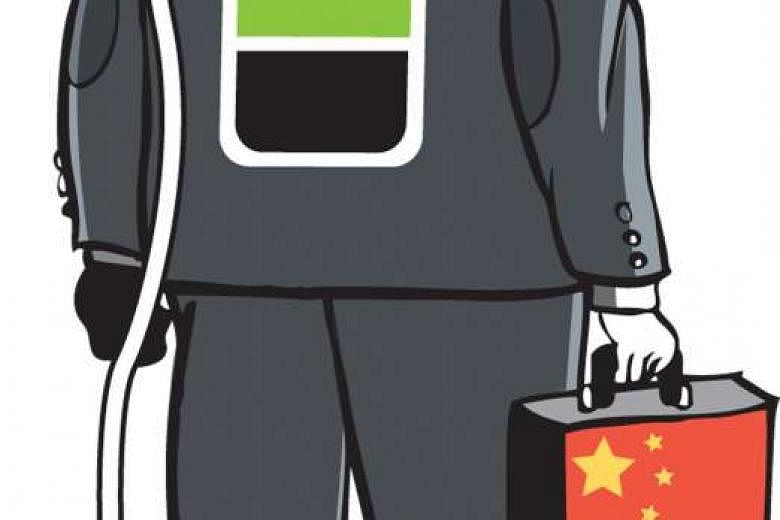A few weeks ago, the country head in China for a major Asian conglomerate gave me an insight into the ingenious ways in which some on the mainland were moving money out of Asia's biggest economy.
A business from which his company buys millions of dollars of infrastructure equipment approached him with a request: Make a claim that several lots of the machinery we exported to you were defective and demand damages. The company will not contest the claim and will proceed to reimburse you for the "faulty" goods. Once you get the money, transfer it - for a fee you may charge - to an account overseas we'll tell you about.
"The amount sought to be pulled out was US$30 million (S$40.2 million) and the trust level was US$3 million a time," this person told me. "Every US$3 million we transferred faithfully into the account, we'd get a slice. He was requesting 10 such tranches."
This person contacted his headquarters, which firmly rejected the plan. There had been no issue with the equipment supplied. Nevertheless, the story adds to anecdotal evidence of the large amounts of funds still leaving China. Some think as much as a trillion dollars may have left the country since August last year, finding their way into assets overseas. A resident of Vancouver, Canada, told this writer his C$800,000 (S$837,000) suburban home was getting offers of as much as C$1.4 million from Chinese investors as they looked for parking slots for their funds.
Visiting China, the signs of an economy that's run into some sort of a wall are plain to see. The buzz has faded. Hotel lobbies no longer overflow with foreigners looking to cut deals. Large blocks of apartments are visibly empty - you can make out from the unlit homes. Fewer cranes dot the landscape as the construction boom has eased.

That's the old China, or, put another way, the recently modernised China. This is the China that's gorged itself on debt. The China whose state-owned enterprises, inefficient for the most part, but kept alive nevertheless out of socio-political compulsions, still seem to flourish.
The China whose shadow banking sector had taken on fearsome proportions. The China whose banks may be saddled with as much as a fifth of loans gone sour. Indeed, businessmen late on repayments are astounded when bankers tell them they'll roll over the loans at extremely friendly terms - "anything but the word 'default', please", seems to be the motto.
Data released last Friday for last month hold out little hope of cheer, raising questions of where China is finding its claimed growth rate of 6.7 per cent. Factory output, investments and retail sales were all seen slowing. There is fear of the economy falling into a so-called liquidity trap where investors prefer to hold on to cash rather than deploy it in investments. The International Monetary Fund recently advised the country to scale back its reliance on credit-fuelled investment to meet "unsustainably high growth targets".
Surprised? No reason to be. These are some of the factors that led speculators to short the Chinese currency earlier this year, certain that ever-wider torrents of cash would gush out of China after the sharp devaluation they considered to be inevitable.
REBOUND ON THE CARDS
Those that did so may live to rue their decisions. The Chinese government has staved off the challenge. From about February, the capital outflows seem to have ebbed, although they ticked up a mite last month. Forex reserves have remained stable at a little more than US$3 trillion after suffering a sharp fall in the first quarter of the year.
Clearly, the People's Bank of China (PBOC), which seemed to be fumbling all over for most of last year, seems to be in a better position to allow the yuan to move up and down without triggering excessive capital flight. Sure, they got lucky too. The US Federal Reserve's decision to take a pause in its interest rate tightening policy removed another opportunity for the money sloshing around in China to seek higher returns abroad. Even so, for the next few months, the talk of a China hard landing predicted by the likes of Mr George Soros will not go away.
But some things are happening inside the massive economy that point to the future and that future isn't dismal. Indeed, the rebound, when it comes, may not only catch the world unawares but also leave it scrambling to meet the challenge.
The best piece of news emerging from China is that some analysts think it is poised to see the end of four years of deflation as it succeeds in cutting output in some key sectors, thus aligning supply closer to demand. Producer prices last month, in fact, were a shade higher than the previous month, led by metals. Likewise, in steel, the excess capacity that led China to dump its products on global markets has been trimmed.
The rebalance of the economy is making progress, although some think it should move faster. Consumption is expanding steadily. China is now the biggest market for cars, having passed the US. It is also the largest market for iPhones. The surge in e-commerce - Alibaba's billings grew some 40 per cent last year over the previous year - masks a part of this boom because it takes place out of sight. This week, Goldman Sachs, the US investment bank, released a report that points to the new, consumption-based economy the Chinese are building.
And in so many ways, it is moving up the value chain. Footwear, clothing and toys were in the top five categories of Chinese exports in 1995, Goldman noted. Two decades later, it was telecom equipment, automatic data-processing machines, cathode valves, furniture and jewellery.
Meanwhile, appetite for "new economy" commodities, such as soya beans, nickel and petrol, have boomed in recent years, versus "old economy" resources like wheat, steel and diesel, which have been relatively stable. How do you explain this? Goldman says soya beans are often used as animal feed in countries where the demand for meat and dairy is high, nickel is used to make stainless alloys for industrial and consumer products, while petrol, jet fuel and LPG are better indicators of consumption than industrial-related products like diesel and fuel oil.
NEW DIRECTIONS
China also is moving in some surprising directions. Amid a global glut in commodities, including oil and gas, it is steadily expanding its production of natural gas. At first sight, this seems like a silly move. Why spend so much on shale extraction when you can get it cheaper from abroad? But Beijing is moving on two planks: Firstly, this assures employment to large swathes of workers. Secondly, it affords the prospect of a cleaner future than the one on which the nation's current sinews are built. Steadily, as in so many other areas, China is lengthening its domestic supply chain in a variety of areas.
And it is building its own world-class companies. In June, at the annual Meeting of the New Champions organised by the World Economic Forum in Tianjin, I sat listening to Mr Travis Kalanick, the founder of Uber, treated like a rock star as he waxed confident about Uber in the Chinese market. Less than a month later, he had surrendered there to Uber's local rival, Didi Chuxing. A whole host of tech companies are emerging, and attracting attention for their innovativeness. As The Economist noted recently, there is nothing in the world to rival the mobile operating system WeChat's combination of voice call, gaming, browsing and payment features.
But the most impressive strides may be in automation and robotisation. ABB, the Swiss automation giant, has designed small robots tailored for the China market. These are sensitive enough to work on the dashboards of cars, or unscrew a bottle. In time, robots will be available that could be deployed in handling ever more delicate tasks, such as working on silk. In Dongguan, a key spot in its manufacturing map, many factories are dark by day and night - robotisation has made lighting, important for workers to move around the factory floor safely, unnecessary.
China emerged as the world's top importer of robots two years ago. Last year, it accounted for a quarter of all robotic equipment sold in the world. That demand is expected to double by the end of 2018 and China is determined to own not just robots, but the technology as well. At this year's Hannover industrial fair, the German company Kuka showed off Iiwa, an ultra-sensitive robot that can brew a cup of coffee. A few weeks later, the Chinese company Midea announced that it now held 95 per cent of Kuka, having paid some US$5 billion to raise its stake in the company from the 13.5 per cent it earlier held.
What about quality and service standards? These are moving up as well. Mr Geoff Broderick, who heads the Asia-Pacific region for JD Power Associates, a market research consultancy, was recently quoted as saying that he expects the quality gap between Chinese- and foreign-made cars to vanish in the "next two to three years".
Services as a percentage of GDP pushed past the 50 per cent mark last year. Standards are rising here, too. I flew Air China from London to Beijing recently and could not help noticing how the in-flight service had noticeably improved compared with my experience just over a year ago. Clearly, the effort to understand the services game is gaining traction.
All this will not happen in a day. Nor a year. But added up, they point to a China that will be a formidable competitor not just in the areas we are familiar with, but in new areas that the rest of us thought we had an edge. Make no mistake: A second wind is building in China. Be prepared to feel the gusts.


